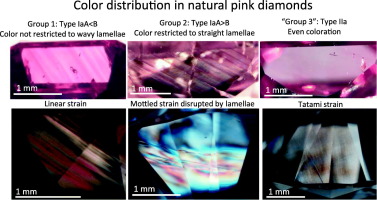当前位置:
X-MOL 学术
›
Diam. Relat. Mater.
›
论文详情
Our official English website, www.x-mol.net, welcomes your
feedback! (Note: you will need to create a separate account there.)
Comparison of gemological and spectroscopic features in type IIa and Ia natural pink diamonds
Diamond and Related Materials ( IF 4.3 ) Pub Date : 2020-05-01 , DOI: 10.1016/j.diamond.2020.107784 Sally Eaton-Magaña , Garrett McElhenny , Christopher M. Breeding , Troy Ardon
Diamond and Related Materials ( IF 4.3 ) Pub Date : 2020-05-01 , DOI: 10.1016/j.diamond.2020.107784 Sally Eaton-Magaña , Garrett McElhenny , Christopher M. Breeding , Troy Ardon

|
Abstract The majority of natural pink diamonds have a color origin due to absorption from a broad 550 nm band that has been associated with plastic deformation. One consistent feature in the photoluminescence spectra of these pink diamonds is a wide emission band extending from ~600 to 750 nm, with a series of smaller oscillations overlaid on the larger emission band. This “pink emission band” is seen in diamonds colored by the 550 nm absorption band; the absorption band often, but not always, shows similar oscillations at ~600 nm (called the 609 nm system by previous researchers). This emission band served as a proxy for the 550 nm absorption band as we performed spatial mapping to chronicle the differences between the uniform coloration in type IIa pink diamonds and the pronounced banding in type Ia pink diamonds. We also used Raman spectroscopy to identify the internal crystal inclusions present in type IIa pink diamonds and determined that the majority have a sub-lithospheric origin.
中文翻译:

比较 IIa 型和 Ia 型天然粉红色钻石的宝石学和光谱特征
摘要 大多数天然粉红色钻石的颜色来源于与塑性变形相关的 550 nm 宽波段的吸收。这些粉红色钻石的光致发光光谱的一个一致特征是从 ~600 到 750 nm 的宽发射带,在较大的发射带上叠加了一系列较小的振荡。这种“粉红色发射带”出现在由 550 nm 吸收带着色的钻石中;吸收带通常但并非总是在 ~600 nm(以前的研究人员称为 609 nm 系统)处显示类似的振荡。当我们执行空间映射以记录 IIa 型粉红色钻石的均匀着色与 Ia 型粉红色钻石的明显条带之间的差异时,该发射带充当了 550 nm 吸收带的代理。
更新日期:2020-05-01
中文翻译:

比较 IIa 型和 Ia 型天然粉红色钻石的宝石学和光谱特征
摘要 大多数天然粉红色钻石的颜色来源于与塑性变形相关的 550 nm 宽波段的吸收。这些粉红色钻石的光致发光光谱的一个一致特征是从 ~600 到 750 nm 的宽发射带,在较大的发射带上叠加了一系列较小的振荡。这种“粉红色发射带”出现在由 550 nm 吸收带着色的钻石中;吸收带通常但并非总是在 ~600 nm(以前的研究人员称为 609 nm 系统)处显示类似的振荡。当我们执行空间映射以记录 IIa 型粉红色钻石的均匀着色与 Ia 型粉红色钻石的明显条带之间的差异时,该发射带充当了 550 nm 吸收带的代理。











































 京公网安备 11010802027423号
京公网安备 11010802027423号